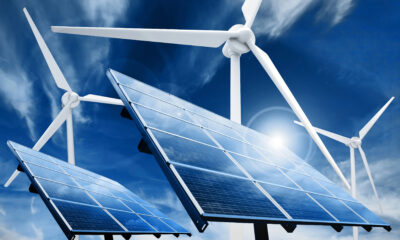

Features
Sustainable plastics: the world’s future materials
Four members of the University of Minnesota’s Centre for Sustainable Polymers write about how making sustainable plastics is not just a pipedream.
Polymers are the giant molecules that make up plastics. These ubiquitous materials protect our foods, make our cars lighter and more efficient, and are in myriad household items.
Nearly all polymers are derived from fossil fuels, led by high-volume products such as polyethylene (PE), polystyrene (PS), and polyvinylchloride (PVC). In both their production and their disposal, these materials present inescapable environmental challenges that are costly to correct in the short-term and unsustainable in the long run.
Fortunately, the advent of a vibrant and growing bio-based chemical industry that does not rely on finite resources such as natural gas and oil as feedstocks provides a new driver for the invention of competitive and sustainable polymers, while simultaneously fuelling economic development and generating green chemistry jobs.
About 300m tons of plastic are produced globally each year, and only about 10% of that is recycled. Roughly 33% of plastic is designed for single use, and then is typically thrown away (e.g., most packaging materials).
Ironically, the very attributes that make plastic so desirable are the same things that make it so problematic. Plastic is inexpensive, lightweight, and durable, which makes it an ideal material for various industries (e.g., retail, packaging and manufacturing). However, because plastic is so desirable the volumes generated are huge, and because it is so durable it does not naturally erode in the environment on reasonable time scales.
Video: Plastics are a vital part of our lives, but they also are rife with adverse environmental impacts. In “Can We Make Plastics Sustainable?”, the University of Minnesota’s Institute on the Environment and the Centre for Sustainable Polymers explore how we can enjoy the benefits of plastics and keep our planet healthy, too.
The accumulation of plastic waste over the last sixty years has culminated in an environmental crisis. One needs only walk a few yards along any of the Earth’s tens of thousands of miles of sandy beach to spot a fractured chunk of yesterday’s shiny new plastic creation.
Moreover, the petroleum market is notoriously volatile, and over the last decade as the price of petroleum has escalated, the cost of raw materials used in the production of polymers has also steadily risen. For example, from 1985-2007 the price of soybean oil in the US grew by just 50% while over the same time period the price of crude oil has risen 150%.
One strategy to address these problems is to use renewable resources to prepare polymeric materials with the same (or even better) properties as traditional plastics, but that will not carry the same environmental taxation associated with petrochemically derived plastics.
The Centre of Sustainable Polymers (CSP) at the University of Minnesota is pursuing this strategy.
The overarching goal of the CSP is to develop a comprehensive knowledge base that enables the efficient and economical conversion of natural and abundant molecules into tomorrow’s advanced polymeric materials. Such plastics are targeted to be compostable and biodegradable, ultimately alleviating the accumulation of plastic waste.
A recent study by the US Department of Agriculture estimated that renewable polymers could account for up to 20% of the global polymer market by 2025, so the future for these types of technology is close at hand.
CSP researchers are tackling the scientific challenges inherent in developing new, sustainable materials through multiple projects using a variety of approaches. For example, studies of the detailed chemical mechanisms by which biorenewable polymers are prepared are leading to the development of new, more efficient polymerisation catalysts.
New building blocks derived from plants for sustainable polymer synthesis are being developed and used to prepare complex polymer architectures that lead to useful properties. Thus, multiblock polymers built from natural starting materials are being pursued as thermoplastic elastomers and pressure sensitive adhesives.
Also, CSP researchers are preparing new vegetable oil-derived polyols that are key components of polyurethane (PU) foams. Polyurethane is one of the most versatile polymeric materials with regard to both processing methods and mechanical properties.
Based on the selection of reactants, the resulting PU can be a rigid material, a flexible elastic substance or even a viscoelastic gel. This wide range of achievable properties makes PUs an indispensable component in building construction, consumer products, transportation and medical devices.
The use of vegetable oil‐derived polyols in foam synthesis is not only desirable but also critical in reducing petroleum components in PU.
The CSP has adopted a multi-disciplinary basic research approach to developing, improving, and expanding bio-based polymers that is well-suited to the inherent challenges associated with innovation and development of these exciting new materials.
The centre has partnered with industry leaders to understand their needs and to seek guidance in research directions, and has also established collaborations with colleagues in the University of Minnesota’s Humphrey School of Public Affairs in order to foster relationships with legislative leaders and participate in policy decisions that may impact the direction of these industries.
Finally, we continue to reach out to the public in order to educate them about the importance of sustainable polymers as the world’s future materials.
Laura Seifert, Marc Hillmyer, Bill Tolman and Tom Hoye are all part of the University of Minnesota’s Centre for Sustainable Polymers.
Further reading:


 Economy12 months ago
Economy12 months agoSustainable Food Packaging Solutions For a Circular Economy

 Energy11 months ago
Energy11 months agoThe Role of Renewable Energy in Commercial Real Estate

 Economy11 months ago
Economy11 months agoWhy Collaboration is Key for a Sustainable Circular Economy

 Energy10 months ago
Energy10 months agoHow Energy Referral Programs are Saving The Planet… And Your Bank Account!
































